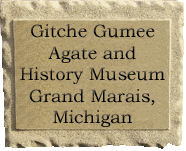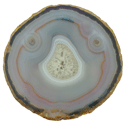MINERAL OF THE MONTH
March 2013 - Jacobsville Sandstone
Jacobsville Sandstone is a red sandstone that has light-colored streaks and spots caused by chemical leaching across the bedding planes. This beautiful rock is found along the Lake Superior shoreline in northern Upper Michigan and Ontario. Scientists also think that Jacobsville lies under much of Lake Superior. There are also other sandstones in Wisconsin and Minnesota that may or may not be the same formation (Freda sandstone, Bayfield Group sandstone). Jacobsville Sandstone is composed of: 27.4% nonundulatory quartz, 27.0% undulatory quartz, 23.0% potassium feldspar, and 12.3% silicic volcanic clasts.
A hundred years ago this rock was mined and used as a building material. It was highly desired for its durability and aesthetics. Over 30 different quarries in the Upper Peninsula extracted Jacobsville sandstone between 1870 and 1915.
Below is a table showing the sandstone sales from 1899 to 1913.
| Year | Total Value |
| 1899 | $178,038 |
| 1900 | $132,650 |
| 1901 | $174,428 |
| 1902 | $188,073 |
| 1903 | $121,350 |
| 1904 | $74,868 |
| 1905 | $123,123 |
| 1906 | $65,395 |
| 1907 | $53,003 |
| 1908 | $39,103 |
| 1909 | $36,084 |
| 1910 | $31,233 |
| 1911 | $12,985 |
| 1912 | $16,438 |
| 1913 | $19,224 |
There is some confusion about this rock since it has had several names including redstone, brownstone, Lake Superior Sandstone, and Eastern Sandstone. In 1907, however, the sedimentary formation was given its current classification and the name Jacobsville, in honor of the town in which some of the quarries were located. There is also disagreement about the age of the sandstone. Most believe that it formed around a billion years ago, but others feel that it is half that age. Since the sandstone is entirely devoid of fossils, the older age classification is more likely.
Today, the best place to see this rock is near Au Sable Point, located around eight miles west of Grand Marais.
 |
|
CITES:
Mineral of the Month Archives
May 2007: Rainbow Fluorite
June 2007: Lake Superior Michipicoten Agate
July 2007: Labadorite
August 2007: Rain Flower Agate
Fall 2007: Malachite
December 2007: Nepheline Syenite
January 2008: Native Copper
February 2008: Amazonite
March 2008: Lake Superior Agate
April 2008: Shadow Agate
May 2008: Apohpylite
June 2008: Ocean Jasper
Summer 2008: Marra Mamba Tiger's Eye
September 2008: Mohawkite
October 2008: Mexican opal
November 2008: Prehnite
December 2008: Picture Jasper
January 2009: Sea Shell Jasper
February 2009: Polychrome Jasper
March 2009: Selenite Desert Rose
Spring 2009: Coyamito Agate
July 2009: Obsidian Needles
August 2009: Goethite
September 2009: Banded Iron Formation
Fall 2009: Fairburn Agate
March 2010: Fossilized Dinosaur Bone
April/May: 2010 Kentucky Agate
June 2010: Nantan Meteorite
July 2010: Mookaite Jasper
Aug/Sept 2010: Polyhedroid Agate
Fall 2010: Ammonite Fossil
September 2011: Petoskey Stones
Spring 2011: Petrfied Wood
Winter 2011: Argentina Condor Agate
January 2012: Mary Ellen Jasper
March 2012: Mexican Crazy Lace Agate
June 2012: Moqui Marbles
September 2012: Chlorastrolite Greenstone
March 2013: Jacobsville Sandstone
August 2013: Unakite
November 2013: Skip-an-Atom Agate
April 2014: Tiger's Eye
September 2014: Black Corundum
February 2015: Condor Agate
June 2015: Petoskey Stone
November 2015: Slag
June 2016: Lake Superior Copper Replacement Agates
March 2017: Chert
July 2017: Kona Dolomite
December 2017: Septarian Nodule
Copyright All rights reserved.
Gitche Gumee Museum.
E21739 Brazel Street
Grand Marais, Michigan 49839











